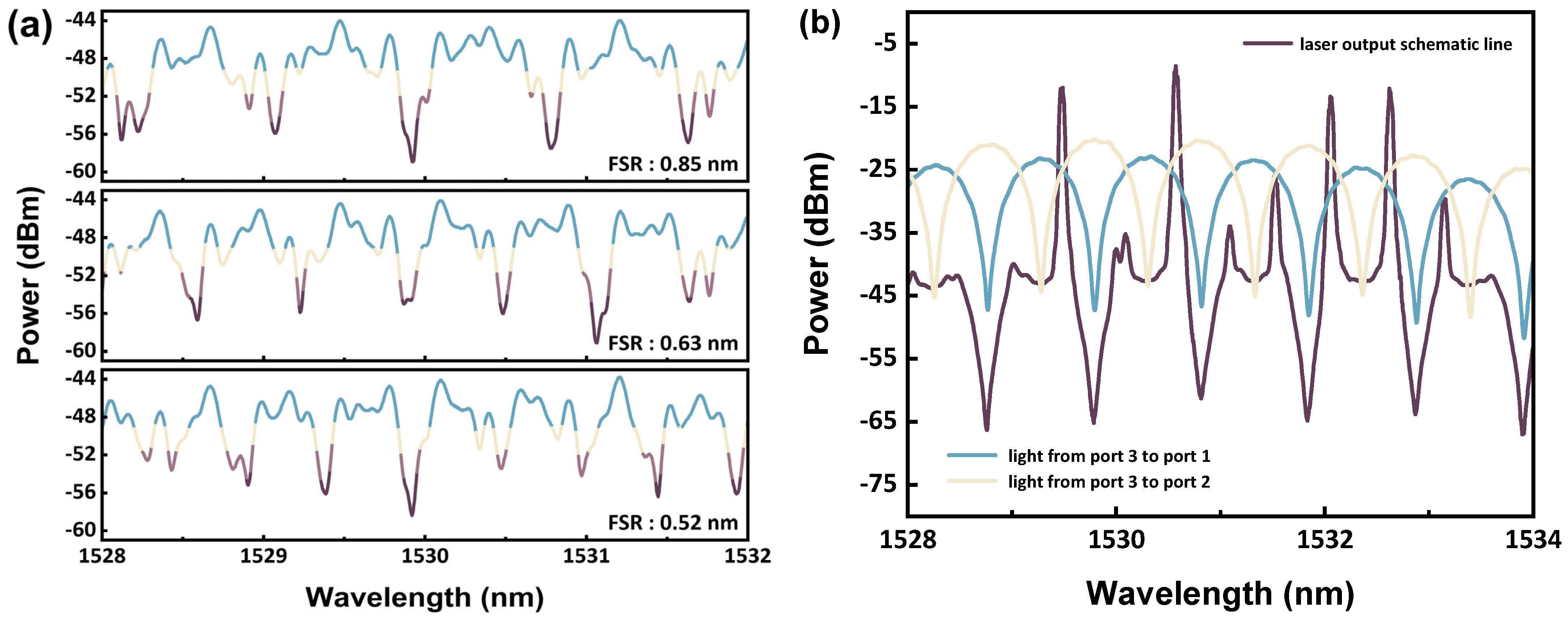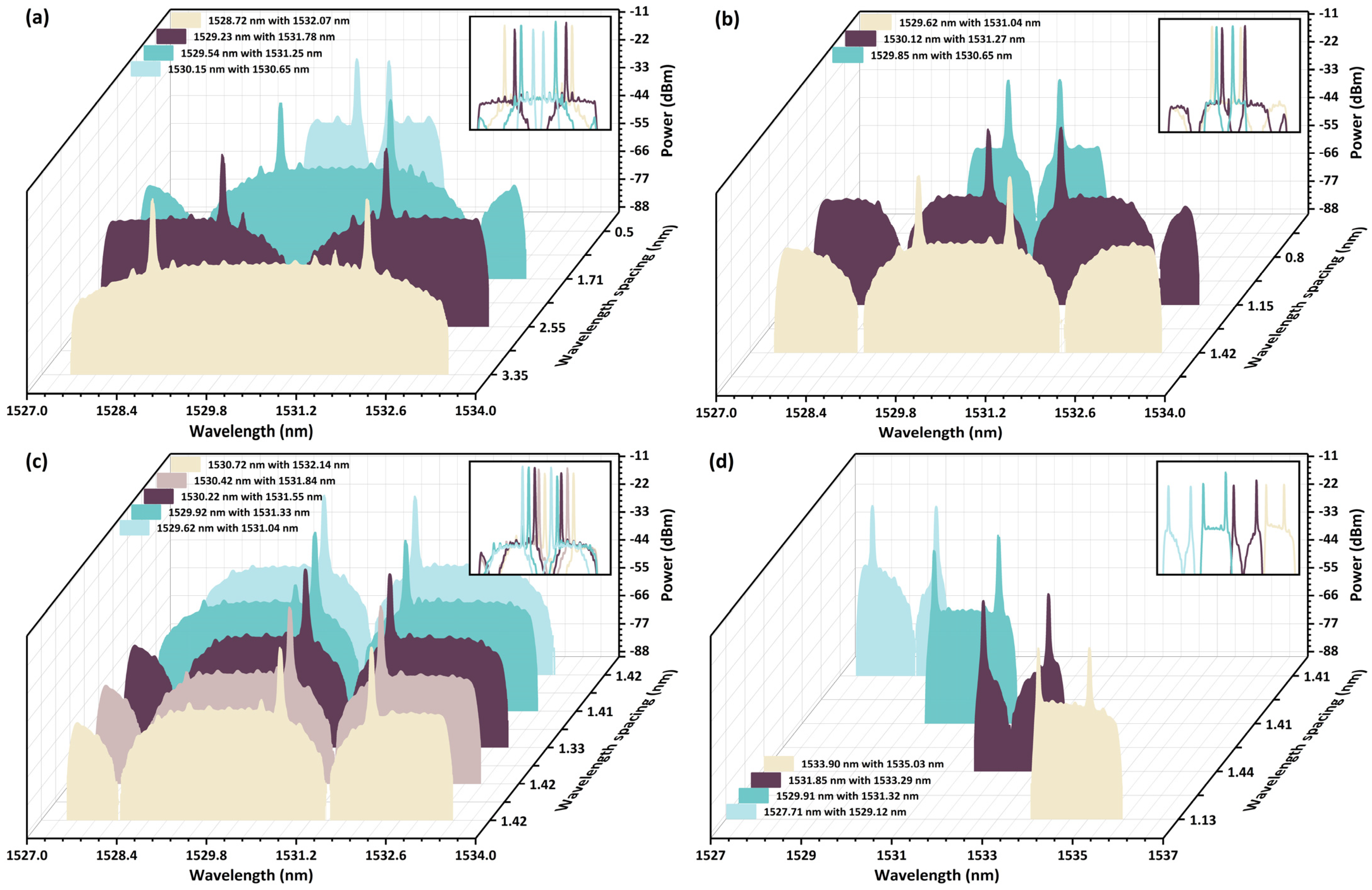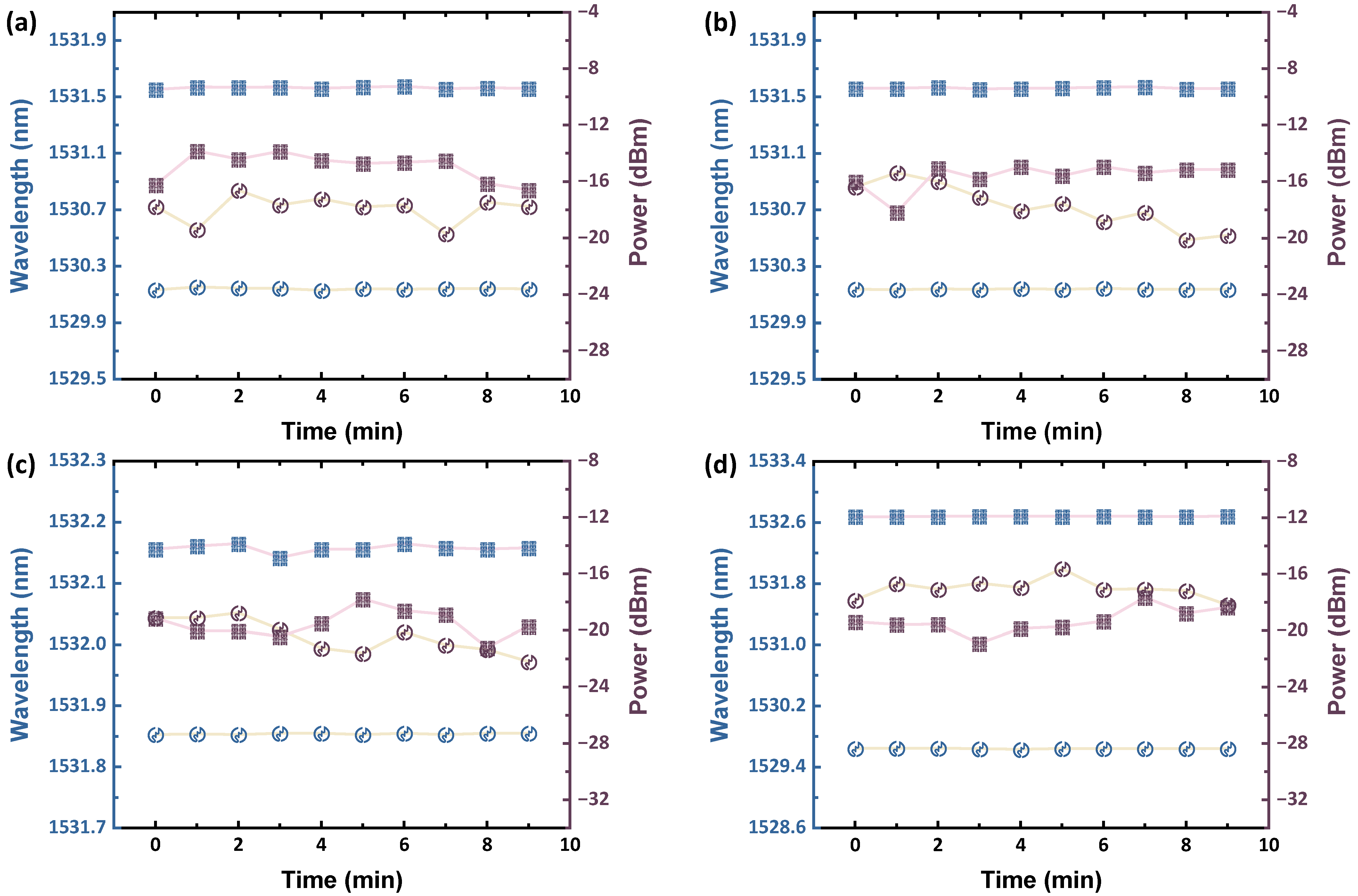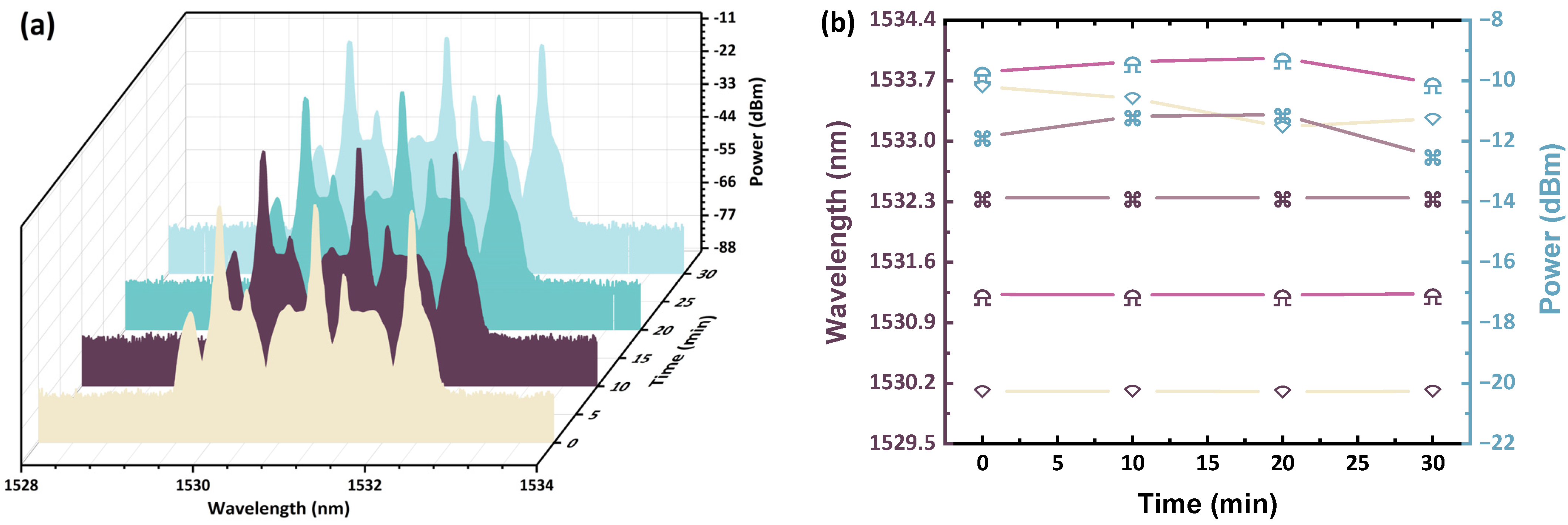A Multi-Format, Multi-Wavelength Erbium-Doped Fiber Ring Laser Using a Tunable Delay Line Interferometer
Abstract
1. Introduction
2. Experimental Setup and Procedures
3. Experimental Results
4. Conclusions
Author Contributions
Funding
Institutional Review Board Statement
Informed Consent Statement
Data Availability Statement
Conflicts of Interest
References
- Nemova, G. Brief Review of Recent Developments in Fiber Lasers. Appl. Sci. 2024, 14, 2323. [Google Scholar] [CrossRef]
- Churkin, D.V.; Sugavanam, S.; Vatnik, I.D.; Wang, Z.; Podivilov, E.V.; Babin, S.A.; Rao, Y.J.; Turitsyn, S.K. Recent advances in fundamentals and applications of random fiber lasers. Adv. Opt. Photon. 2015, 7, 516–569. [Google Scholar] [CrossRef]
- Shi, W.; Fang, Q.; Zhu, X.; Norwood, R.A.; Peyghambarian, N. Fiber lasers and their applications. Appl. Opt. 2014, 53, 6554–6568. [Google Scholar] [CrossRef]
- Addanki, S.; Amiri, I.S.; Yupapin, P. Review of optical fibers-introduction and applications in fiber lasers. Results Phys. 2018, 10, 743–750. [Google Scholar] [CrossRef]
- Kim, T.H. Analysis of optical communications, fiber optics, sensors and laser applications. J. Mach. Comput. 2023, 3, 115–125. [Google Scholar] [CrossRef]
- Lu, H.H.; Huang, X.H.; Li, C.Y.; Xu, Y.Z.; Jin, J.L.; Chen, W.X.; Lin, C.H.; Wu, T.M. Two-way free-space optics-based interface between fibre and 5G communication employing polarisation-orthogonal modulation. Commun. Eng. 2023, 2, 89. [Google Scholar] [CrossRef]
- Dehnaw, A.M.; Manie, Y.C.; Du, L.Y.; Yao, C.K.; Li, Y.L.; Hayle, S.T.; Peng, P.C. Bidirectional Free Space Optics Communication for Long-Distance Sensor System. J. Lightw. Technol. 2023, 41, 5870–5878. [Google Scholar] [CrossRef]
- Peng, P.C.; Jhang, J.J.; Peng, Y.W.; Bitew, M.A.; Chi, Y.C.; Wu, W.C.; Wang, H.Y.; Lin, G.R.; Li, C.Y.; Lu, H.H. Tunable C-and L-band laser source based on colorless laser diode. Laser Phys. Lett. 2017, 14, 035806. [Google Scholar] [CrossRef]
- Manie, Y.C.; Yao, C.K.; Yeh, T.Y.; Teng, Y.C.; Peng, P.C. Laser-based optical wireless communications for internet of things (IoT) application. IEEE Internet Things J. 2022, 9, 24466–24476. [Google Scholar] [CrossRef]
- Dehnaw, A.M.; Shiu, R.K.; Chen, R.B.; Li, J.W.; Manie, Y.C.; Liang, H.C.; Peng, P.C. Self-start multi-wavelength laser source with tunable delay-line interferometer and optical fiber reflector for wireless communication system. Appl. Sci. 2021, 11, 9553. [Google Scholar] [CrossRef]
- Murray, J.B.; Cerjan, A.; Redding, B. Distributed Brillouin fiber laser sensor. Optica 2022, 9, 80–87. [Google Scholar] [CrossRef]
- Yao, C.K.; Manie, Y.C.; Chen, H.M.; Hsu, W.Y.; Lin, T.C.; Peng, P.C. Involvement of free-space optics in Raman distributed temperature sensing. Opt. Lett. 2023, 48, 6340–6343. [Google Scholar] [CrossRef]
- Jati, M.P.; Luthfi, M.I.; Yao, C.K.; Dehnaw, A.M.; Manie, Y.C.; Peng, P.C. An Extremely Close Vibration Frequency Signal Recognition Using Deep Neural Networks. Appl. Sci. 2024, 14, 2855. [Google Scholar] [CrossRef]
- Soares, L.; Perez-Herrera, R.A.; Novais, S.; Ferreira, A.; Frazão, O.; Silva, S. Paracetamol concentration-sensing scheme based on a linear cavity fiber laser configuration. Opt. Fiber Technol. 2023, 80, 103407. [Google Scholar] [CrossRef]
- Soares, L.; Pérez-Herrera, R.A.; Novais, S.; Ferreira, A.; Silva, S.; Frazão, O. Linear Fiber Laser Configurations for Optical Concentration Sensing in Liquid Solutions. Photonics 2024, 11, 393. [Google Scholar] [CrossRef]
- Nemova, G.; Jin, X.; Chen, L.R.; Firstov, S.V.; Sezerman, O. Modeling and experimental characterization of a dual-wavelength Bi-doped fiber laser with cascaded cavities. J. Opt. Soc. Am. B 2020, 37, 1453–1460. [Google Scholar] [CrossRef]
- Nemova, G.; Kashyap, R. Yb3+-doped fiber laser with integrated optical cooler. In Proceedings of the Laser Technology for Defense and Security VI, Orlando, FL, USA, 5–6 April 2010; SPIE: Bellingham, WA, USA, 2015; Volume 7686, pp. 241–247. [Google Scholar]
- Tokita, S.; Murakami, M.; Shimizu, S.; Hashida, M.; Sakabe, S. Liquid-cooled 24 W mid-infrared Er: ZBLAN fiber laser. Opt. Lett. 2009, 34, 3062–3064. [Google Scholar] [CrossRef]
- Topper, B.; Peysokhan, M.; Albrecht, A.R.; Flores, A.S.; Kuhn, S.; Hässner, D.; Hein, S.; Hupel, C.; Nold, J.; Haarlammert, N.; et al. Laser cooling of a Yb doped silica fiber by 18 Kelvin from room temperature. Opt. Lett. 2021, 46, 5707–5710. [Google Scholar] [CrossRef]
- Nishizawa, N. Ultrashort pulse fiber lasers and their applications. Jpn. J. Appl. Phys. 2014, 53, 090101. [Google Scholar] [CrossRef]
- Zhang, L.; Tian, Z.; Chen, N.K.; Grattan, K.T.; Yao, Y.; Rahman, B.A.; Li, X.H.; Yao, C.K.; Han, H.L.; Chui, H.C.; et al. Pulse Dynamics of an All-Normal-Dispersion Ring Fiber Laser Under Four Different Pulse Regimes. IEEE Access 2020, 8, 115263–115272. [Google Scholar] [CrossRef]
- Chen, N.K.; Lin, J.W.; Liu, F.Z.; Liaw, S.K. Wavelength-Tunable Er3+-Doped fs Mode-Locked Fiber Laser Using Short-Pass Edge Filters. IEEE Photon. Technol. Lett. 2010, 22, 700–702. [Google Scholar] [CrossRef]
- Chen, N.K.; Liu, F.Z.; Chuang, H.P.; Lai, Y.; Yang, S.D.; Lin, J.W.; Liaw, S.K.; Chang, Y.C.; Huang, C.B.; Chi, S. Highly efficient femtosecond pulse stretching by tailoring cavity dispersion in erbium fiber lasers with an intracavity short-pass edge filter. Opt. Express 2011, 19, 15879–15884. [Google Scholar] [CrossRef] [PubMed]
- Han, H.; Chen, N.K.; Zhang, L.; Xie, Y.; Tian, Z.; Yao, Y.; Huang, Y.; Zhang, X. Output pulse characteristics of a Mamyshev fiber oscillator. Photonics 2021, 8, 590. [Google Scholar] [CrossRef]
- Yeh, C.H.; Liu, L.H.; Ko, H.S.; Wang, B.Y.; Hsu, W.H.; Chow, C.W.; Chen, J.H. Quad-ring based erbium fiber laser for switchable and stable single-longitudinal-mode operation. Opt. Fiber Technol. 2021, 61, 102450. [Google Scholar] [CrossRef]
- Li, G.H.; Lin, Y.Z.; Chang, H.W.; Yeh, C.H.; Chen, J.R.; Wang, B.Y.; Hsu, W.H.; Chow, C.W.; Liaw, S.K. Stabilized single-longitudinal-mode fiber laser with broadband and flat wavelength output. Phys. Scr. 2020, 96, 015503. [Google Scholar] [CrossRef]
- Yamashita, S.; Takubo, Y. Wide and fast wavelength-swept fiber lasers based on dispersion tuning and their application to optical coherence tomography. Photon. Sens. 2013, 3, 320–331. [Google Scholar] [CrossRef]
- Jiang, H.; Zhao, Z.; Jin, L.; Set, S.Y.; Yamashita, S. Self-wavelength-sweeping in a bi-directional thulium-doped fiber ring laser. Appl. Phys. Express 2019, 12, 042006. [Google Scholar] [CrossRef]
- Chen, H.; Jiang, X.; Xu, S.; Zhang, H. Recent progress in multi-wavelength fiber lasers: Principles, status, and challenges. Chin. Opt. Lett. 2020, 18, 041405. [Google Scholar] [CrossRef]
- Kbashi, H.J.; Sharma, V.; Sergeyev, S.V. Tunable Multiwavelength SOA-Based Fiber Laser. Electronics 2023, 12, 3277. [Google Scholar] [CrossRef]
- Imbu, J.J.; Bitew, M.A.; Chang, C.H.; Tang, W.C.; Manie, Y.C.; Peng, P.C. Multi-wavelength generation? Based on RSOA for passive optical networks. In Proceedings of the 2017 IEEE International Conference on Consumer Electronics-Taiwan (ICCE-TW), Taipei, Taiwan, 12–14 June 2017. [Google Scholar]
- Peng, P.C.; Tseng, H.Y.; Chi, S. Long-distance FBG sensor system using a linear-cavity fiber Raman laser scheme. IEEE Photonics Technol. Lett. 2004, 16, 575–577. [Google Scholar] [CrossRef]
- Awsaj, M.K.; Al-Mashhadani, T.F.; Al-Mashhadani, M.K.S.; Hammudi, R.N.; Ali, A.Y.; Zan, M.S.D.; Arsad, N. Tunable 60 GHz Multiwavelength Brillouin Erbium Fiber Laser. Appl. Sci. 2023, 13, 3275. [Google Scholar] [CrossRef]
- Wang, T.; Yang, A.; Shi, F.; Huang, Y.; Wen, J.; Zeng, X. High-order mode lasing in all-FMF laser cavities. Photon. Res. 2019, 7, 42–49. [Google Scholar] [CrossRef]
- Radzi, N.M.; Latif, A.A.; Ismail, M.F.; Liew, J.Y.; Awang, N.A.; Lee, H.K.; Ahmad, F.; Norizan, S.F.; Ahmad, H. Tunable spacing dual-wavelength Q-switched fiber laser based on tunable FBG device. Photonics 2021, 8, 524. [Google Scholar] [CrossRef]
- Gao, M.; Yin, B.; Lv, Y.; Sang, G.; Hou, B.; Li, H.; Wang, M.; Wu, S. Tunable and switchable dual-wavelength SLM Narrow-linewidth fiber laser with a PMFBG-FP filter cascaded by multi-ring cavity. Photonics 2022, 9, 756. [Google Scholar] [CrossRef]
- He, W.; Li, D.; Zhu, L.; Dong, M.; Luo, F. Tunable multiwavelength erbium-doped fiber laser employing PM-FBG and Mach–Zehnder interferometer with optical fiber delay line. IEEE Photon. J. 2017, 9, 7202108. [Google Scholar] [CrossRef]
- Zhou, X.; Li, Z.; Zhou, Y. Tunable and switchable multi-wavelength fiber laser based on polarization hole burning effect and Sagnac loop mirrors. Opt. Quantum Electron. 2020, 52, 451. [Google Scholar] [CrossRef]
- Ahmad, H.; Jasim, A.A. Stable C-band fiber laser with switchable multi-wavelength output using coupled microfiber Mach-Zehnder interferometer. Opt. Fiber Technol. 2017, 36, 105–114. [Google Scholar] [CrossRef]
- Martinez-Ramirez, L.G.; Alvarado, E.S.; Gallegos-Arellano, E.; Fernandez-Jaramillo, A.A.; Estudillo-Ayala, J.M.; Jauregui-Vazquez, D.; Rojas-Laguna, R.; Sierra-Hernandez, J.M. Select-cutoff Mach-Zehnder interferometer based on waist-enlarged technique and its multi-wavelength fiber laser application. Infrared Phys. Technol. 2023, 128, 104508. [Google Scholar] [CrossRef]
- Lopez-Dieguez, Y.; Estudillo-Ayala, J.M.; Jauregui-Vazquez, D.; Herrera-Piad, L.A.; Sierra-Hernandez, J.M.; Garcia-Mina, D.F.; Gallegos-Arellano, E.; Hernandez-Garcia, J.C.; Rojas-Laguna, R. Erbium ring fiber laser cavity based on tip modal interferometer and its tunable multi-wavelength response for refractive index and temperature. Appl. Sci. 2018, 8, 1337. [Google Scholar] [CrossRef]
- Tian, Z.; Chen, N.K.; Shum, P.P.; Yao, C.K.; Zhang, L.; Yao, Y.; Grattan, K.T.V.; Ren, S.; Wu, Q. Erbium-doped dual wavelength fiber laser interferometric proximity sensor with ±16 nm measurement accuracy. In Proceedings of the CLEO: QELS_Fundamental Science, San Jose, CA, USA, 9–14 May 2021; Optica Publishing Group: Washington, DC, USA, 2021. [Google Scholar]
- Geng, X.; Jiang, Y.; Gu, H.; Luo, S.; Sun, M.; Li, L. Switchable multi-wavelength fiber lasers based on asymmetric biconical fiber tapers. Opt. Commun. 2023, 548, 129837. [Google Scholar] [CrossRef]
- Torres-Torres, M.; Salceda-Delgado, G.; Rodríguez-Carreón, V.C.; Martinez-Rios, A.; Sierra-Hernandez, J.M.; Antonio-Lopez, J.E.; Amezcua-Correa, R.; Estudillo-Ayala, J. Reshaping the output of fiber lasers by using a variable intra-cavity filter based on a reconfigurable Fabry–Perot interferometer. Laser Phys. 2021, 31, 035102. [Google Scholar] [CrossRef]
- Chang, Y.; Pei, L.; Ning, T.; Zheng, J. Switchable multi-wavelength fiber laser based on hybrid structure optical fiber filter. Opt. Laser Technol. 2020, 124, 105985. [Google Scholar] [CrossRef]
- Tang, Z.; Lou, S.; Wang, X. Stable and widely tunable single-/dual-wavelength erbium-doped fiber laser by cascading a twin-core photonic crystal fiber based filter with Mach-Zehnder interferometer. Opt. Laser Technol. 2019, 109, 249–255. [Google Scholar] [CrossRef]
- Filoteo-Razo, J.D.; Hernandez-Garcia, J.C.; Estudillo-Ayala, J.M.; Pottiez, O.; Jauregui-Vazquez, D.; Sierra-Hernandez, J.M.; Lauterio-Cruz, J.P.; Carrillo-Delgado, C.M.; Rojas-Laguna, R. Multi-wavelength Er–Yb-doped fibre ring laser using a double-pass Mach–Zehnder interferometer with a Sagnac interferometer. Opt. Laser Technol. 2021, 139, 106994. [Google Scholar] [CrossRef]
- Chang, Y.; Pei, L.; Ning, T.; Zheng, J.; Li, J.; Xie, C. Switchable and tunable multi-wavelength fiber ring laser employing a cascaded fiber filter. Opt. Fiber Technol. 2020, 58, 102240. [Google Scholar] [CrossRef]
- Huang, B.; Sheng, X.; Tang, Z.; Lou, S. High SMSR and widely tunable multi-wavelength erbium doped fiber laser based on cascaded filters. Infrared Phys. Technol. 2022, 122, 104082. [Google Scholar] [CrossRef]
- Yao, C.K.; Lee, M.C.; Peng, P.C. EDFA-Based Multi-Wavelength Laser Using Tunable Filter and Delay-Interferometer for WDM Systems. In Proceedings of the 2022 IEEE International Conference on Consumer Electronics-Taiwan (ICCE-TW), Beitou, Taipei, Taiwan, 6–8 July 2022. [Google Scholar]
- Fan, B.; Zhou, X.; Li, Z.; Zhou, Y.; Wang, T. Experimental research on an L-band multi-wavelength erbium-doped fiber laser based on a cascaded Sagnac loop and M–Z filters. Laser Phys. 2019, 29, 065102. [Google Scholar] [CrossRef]
- He, W.; Yuan, H.; Lou, X.; Zhu, L.; Dong, M. Multi-wavelength switchable erbium-doped fiber laser based on a hybrid filter incorporating a bi-tapered Mach–Zehnder interferometer and Sagnac loop. Phys. Scr. 2019, 94, 125502. [Google Scholar] [CrossRef]
- Zhou, X.; Ni, Y.; Wei, Y. L-Band multi-wavelength erbium-doped fibre laser based on non-linear optical loop mirror and dual-channel Mach–Zehnder interferometer. J. Mod. Opt. 2017, 64, 210–213. [Google Scholar] [CrossRef]
- Herrera-Piad, L.A.; Marrujo-García, S.; Hernández-Romano, I.; May-Arrioja, D.A.; Minkovich, V.P.; Torres-Cisneros, M. Highly Stable Switchable Emissions of an Erbium-Doped Fiber Ring Laser Using Cascaded MZIs Based on CHCF. Machines 2022, 10, 962. [Google Scholar] [CrossRef]
- Tian, X.; Zhang, L.; Yao, Y.; Xu, H.; Zhu, K.; Zhang, X.; Nie, Z. Interval Adjustable Dual-Wavelength Erbium-Doped Fiber Laser Based on Cascaded Two Mach-Zehnder Interferometers. Photonics 2023, 10, 1156. [Google Scholar] [CrossRef]
- Zhang, L.; Tian, Z.; Chen, N.K.; Han, H.; Liu, C.N.; Grattan, K.T.; Rahman, B.M.A.; Zhou, H.; Liaw, S.K.; Bai, C. Room-temperature power-stabilized narrow-linewidth tunable erbium-doped fiber ring laser based on cascaded Mach-Zehnder interferometers with different free spectral range for strain sensing. J. Light. Technol. 2020, 38, 1966–1974. [Google Scholar] [CrossRef]
- Peng, Y.; Peng, J.; Pan, H.; Zhang, A.; Liu, Z.; Chen, Z.; Zhang, B.; Liu, X.; Cao, C.; Du, P. Switchable multi-wavelength actively Q-switched erbium-doped fiber laser based on nonlinear polarization rotation and Sagnac filter. Optik 2023, 284, 170955. [Google Scholar] [CrossRef]
- Al-Rubaiyee, H.A.; Al-Hayali, S.K.; Harun, S.W.; Al-Janabi, A.H. Vernier effect based on cascading two Mach–Zehnder interferometers for selectable comb filter and saturable absorber applications in erbium-doped fiber laser. Opt. Fiber Technol. 2024, 84, 103757. [Google Scholar] [CrossRef]
- Al-Rubaiyee, H.A.; Al-Hayali, S.K.; Al-Janabi, A.H. Vernier effect based on hybrid fiber interferometers: A new tool for wavelength switchability and adjustable free spectral range fiber lasing. Opt. Contin. 2023, 2, 1203–1215. [Google Scholar] [CrossRef]
- Yin, G.; Lou, S.; Wang, X.; Han, B. Tunable multi-wavelength erbium-doped fiber laser by cascading a standard Mach–Zehnder interferometer and a twin-core fiber-based filter. Laser Phys. Lett. 2013, 10, 125110. [Google Scholar] [CrossRef]
- Jachpure, D.; Vijaya, R. Mixed line broadening in the saturable absorption of erbium-doped fiber. Opt. Quantum Electron. 2023, 55, 113. [Google Scholar] [CrossRef]
- Yamashita, S.; Hotate, K.J.E.L. Multiwavelength erbium-doped fibre laser using intracavity etalon and cooled by liquid nitrogen. Electron. Lett. 1996, 32, 1298–1299. [Google Scholar] [CrossRef]
- Park, N.; Wysocki, P.F. 24-line multiwavelength operation of erbium-doped fiber-ring laser. IEEE Photon. Technol. Lett. 1996, 8, 1459–1461. [Google Scholar] [CrossRef]
- Dejband, E.; Yao, C.K.; Manie, Y.C.; Huang, P.Y.; Lee, H.K.; Tan, T.H.; Peng, P.C. Utilizing a Tunable Delay Line Interferometer to Improve the Sensing Accuracy of an FBG Sensor System. Photonics 2022, 9, 11. [Google Scholar] [CrossRef]
- Hénault, F. Quantum physics and the beam splitter mystery. In Proceedings of the Nature of Light: What are Photons? VI, San Diego, CA, USA, 10–13 August 2015; SPIE: Bellingham, WA, USA, 2015; Volume 9570, pp. 199–213. [Google Scholar]
- Yang, X.; Kweun, J.M.; Kim, Y.Y. Theory for perfect transmodal Fabry-Perot interferometer. Sci. Rep. 2018, 8, 69. [Google Scholar] [CrossRef] [PubMed]
- Bennett, W.R., Jr. Hole burning effects in a He-Ne optical maser. Phys. Rev. 1962, 126, 580. [Google Scholar] [CrossRef]
- Haken, H.; Sauermann, H. Frequency shifts of laser modes in solid state and gaseous systems. Z. Für Phys. 1963, 176, 47–62. [Google Scholar] [CrossRef]
- Bebawi, J.A.; Kandas, I.; El-Osairy, M.A.; Aly, M.H. A comprehensive study on EDFA characteristics: Temperature impact. Appl. Sci. 2018, 8, 1640. [Google Scholar] [CrossRef]
- Ma, Y.; Stewart, L.; Armstrong, J.; Clarke, I.G.; Baxter, G. Recent progress of wavelength selective switch. J. Lightw. Technol. 2020, 39, 896–903. [Google Scholar] [CrossRef]
- Zhang, Y.; He, Z.; Wu, Z.; Ren, J.; Liu, B.; Lei, T.; Yuan, X. Ultrabroadband 2D-Dispersive Wavelength Selective Switch with 1.57 GHz Hyperfine Spectral Resolution and >1600 Channels. Laser Photon. Rev. 2023, 17, 2300232. [Google Scholar] [CrossRef]







Disclaimer/Publisher’s Note: The statements, opinions and data contained in all publications are solely those of the individual author(s) and contributor(s) and not of MDPI and/or the editor(s). MDPI and/or the editor(s) disclaim responsibility for any injury to people or property resulting from any ideas, methods, instructions or products referred to in the content. |
© 2024 by the authors. Licensee MDPI, Basel, Switzerland. This article is an open access article distributed under the terms and conditions of the Creative Commons Attribution (CC BY) license (https://creativecommons.org/licenses/by/4.0/).
Share and Cite
Yao, C.-K.; Dehnaw, A.M.; Peng, P.-C. A Multi-Format, Multi-Wavelength Erbium-Doped Fiber Ring Laser Using a Tunable Delay Line Interferometer. Appl. Sci. 2024, 14, 6933. https://doi.org/10.3390/app14166933
Yao C-K, Dehnaw AM, Peng P-C. A Multi-Format, Multi-Wavelength Erbium-Doped Fiber Ring Laser Using a Tunable Delay Line Interferometer. Applied Sciences. 2024; 14(16):6933. https://doi.org/10.3390/app14166933
Chicago/Turabian StyleYao, Cheng-Kai, Amare Mulatie Dehnaw, and Peng-Chun Peng. 2024. "A Multi-Format, Multi-Wavelength Erbium-Doped Fiber Ring Laser Using a Tunable Delay Line Interferometer" Applied Sciences 14, no. 16: 6933. https://doi.org/10.3390/app14166933
APA StyleYao, C.-K., Dehnaw, A. M., & Peng, P.-C. (2024). A Multi-Format, Multi-Wavelength Erbium-Doped Fiber Ring Laser Using a Tunable Delay Line Interferometer. Applied Sciences, 14(16), 6933. https://doi.org/10.3390/app14166933







